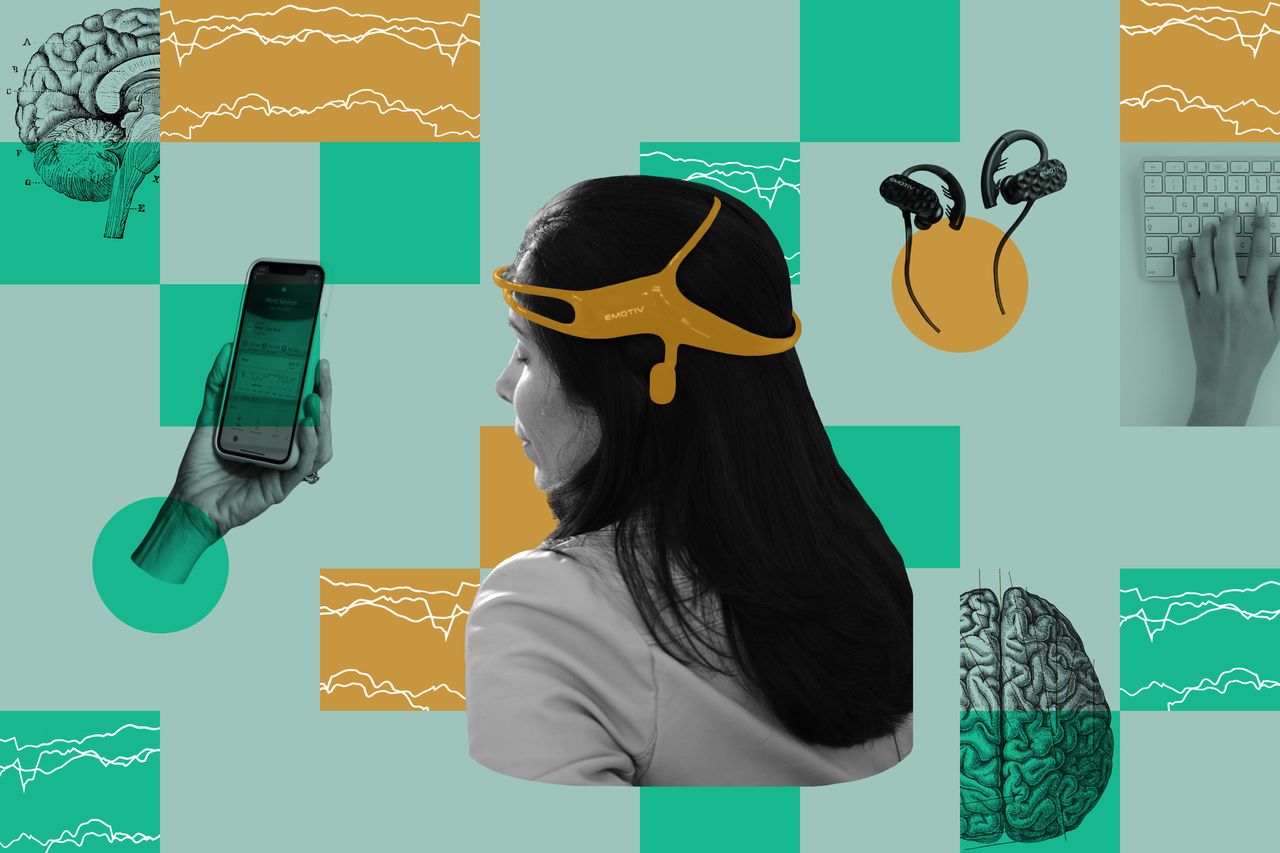When Your Boss Is Tracking Your Brain
Bioethicist Nita Farahany says privacy law hasn’t kept up with science as employers increasingly use neurotechnology in the workplace
Employers can track workers’ emails, computer keystrokes and calls. What happens when they routinely start tracking employees’ brains?
Nita Farahany, 46, has been studying the possibility for years. A professor of law and philosophy at Duke University School of Law, Dr. Farahany has long been intrigued by potential legal challenges posed by devices in the workplace that measure electrical activity in the brain.
Over the years, these electroencephalogram, or EEG, devices, along with the software and algorithms that power them, have gotten better at tracking brain-wave signals and decoding people’s emotions and cognitive skills. Some employers use the devices to monitor employees’ fatigue and offer brain-wave tracking as part of wellness programs designed to decrease stress and anxiety, Dr. Farahany says.
But the law hasn’t kept up with the science, she says. “There is no existing set of legal rights that protect us from employers scanning the brain or hacking the brain.”

Dr. Farahany’s interest in the issue stems in part from her childhood. Her parents both came to the U.S. from Iran, her father moving in 1969 for a medical residency and her mother arriving a year later. They had planned to return to Iran in 1979 but decided against it because of the political unrest. After the Shah of Iran’s ouster, her mother’s brother, who had served in the military, was arrested. Dr. Farahany’s family often discussed politics, including the way surveillance technology can be misused by governments.
In her book coming out in March, “The Battle for Your Brain: Defending the Right to Think Freely in the Age of Neurotechnology,” Dr. Farahany argues the workplace will be a crucial arena in the fight for the future of mental privacy. She spoke with The Wall Street Journal about how employers are increasingly gathering workers’ brain data and the need for limits on how the information is used.
How are employers already tracking our brains?
The first example that I came across was a few years ago. Train drivers in China on the Beijing-Shanghai [high-speed rail] line are required to wear caps that have electrodes embedded in order to track their brain activity to see if they are focused or fatigued. There are even reports of tracking of the emotion levels of factory workers. The workers can be sent home if emotional levels signal they could be disruptive on the factory floor. I thought, I’m glad that isn’t happening in the U.S. But it turns out that it is happening in the U.S. Some companies have started to look into technology that could allow them to track fatigue levels and also attention and focus.
There are some beneficial uses. Brain-wave activity monitors can be used by employees. As your mind starts to wander, it can give you an alert and tell you, “Hey, it is time for a brain break.”
Companies are also using it to track wellness and health. Wellness programs don’t fall under the same kinds of protections that employees have from misuse of health data. The data could track everything from a person’s cognitive decline over time to a lot of other brain metrics, through brain-training games and headsets that measure brain-wave activity.
Can you see employers gathering the data through wellness programs and then sharing a report every quarter?
They could. They could evaluate it. They could use it for managerial purposes. They can make decisions about who is going to be very expensive to continue to employ over time, whose brain is slowing and less likely to be as effective over time. There really is no check on how they use that data right now.
In many instances, we voluntarily give up this information. And in other instances, we don’t have a choice, it is part of the process of applying for a job. What troubles you?
People may not recognise how much information you can decode already from a person’s brain. There are a lot of things that can be learned about the individual, like whether they suffer from cognitive decline or whether they have early stages of glioblastoma, a brain tumour—even their cognitive preferences.
I do worry people are unwittingly giving up [information] without realising the full implications. That is true for privacy in general, but we ought to have a special place we think about when it comes to the brain. It is the last space where we truly have privacy.
If employers collect brain data over time, could they go back and reanalyzs the raw data?
Technologists in the field a decade ago would have told people, “What are you worried about collecting neural data, there is so little we will ever be able to decode from surface-based electrodes rather than ones that are implanted in the brain.” They don’t say that anymore.
They recognise that we can already do so much more than we ever expected. As the algorithms get better and the more data we amass, the more precise the models become.
Given that most of this data is being uploaded to cloud servers and kept there indefinitely, you can have very significant longitudinal data. I hired this person when they were 23 and they are 43 now, how effective is their brain at this point? Have they served their good useful lifetime of service to us?
One of the things in your book is the idea that the brain waves reveal biases that we are not conscious of and can present us in our worst possible light. How does that work exactly?
Yes, potentially. The question is how effectively are they going to be able to do that in real time today. Can they set you up with a headset and probe your brain and figure out how you are reacting? Probably not. In the future can they do it? I think so.
Are there ways people can protect themselves?
We can and should require employers to do better. To say, here’s a transparent way that we’re planning on implementing [best practices] in the workplace. We’re giving the data to you to use. We’re not storing it.
There is a real risk that people won’t have choices. You can’t choose to interview with the only company that doesn’t use brain-based metrics if everybody decides to use them. So I think it’s a combination of people looking out for themselves but also putting into place appropriate default rules at the government level and trying to encourage corporate responsibility.
Interview has been condensed and edited.
 Copyright 2020, Dow Jones & Company, Inc. All Rights Reserved Worldwide. LEARN MORE
Copyright 2020, Dow Jones & Company, Inc. All Rights Reserved Worldwide. LEARN MORE
This stylish family home combines a classic palette and finishes with a flexible floorplan
Just 55 minutes from Sydney, make this your creative getaway located in the majestic Hawkesbury region.
As Paris makes its final preparations for the Olympic games, its residents are busy with their own—packing their suitcases, confirming their reservations, and getting out of town.
Worried about the hordes of crowds and overall chaos the Olympics could bring, Parisians are fleeing the city in droves and inundating resort cities around the country. Hotels and holiday rentals in some of France’s most popular vacation destinations—from the French Riviera in the south to the beaches of Normandy in the north—say they are expecting massive crowds this year in advance of the Olympics. The games will run from July 26-Aug. 1.
“It’s already a major holiday season for us, and beyond that, we have the Olympics,” says Stéphane Personeni, general manager of the Lily of the Valley hotel in Saint Tropez. “People began booking early this year.”
Personeni’s hotel typically has no issues filling its rooms each summer—by May of each year, the luxury hotel typically finds itself completely booked out for the months of July and August. But this year, the 53-room hotel began filling up for summer reservations in February.
“We told our regular guests that everything—hotels, apartments, villas—are going to be hard to find this summer,” Personeni says. His neighbours around Saint Tropez say they’re similarly booked up.
As of March, the online marketplace Gens de Confiance (“Trusted People”), saw a 50% increase in reservations from Parisians seeking vacation rentals outside the capital during the Olympics.
Already, August is a popular vacation time for the French. With a minimum of five weeks of vacation mandated by law, many decide to take the entire month off, renting out villas in beachside destinations for longer periods.
But beyond the typical August travel, the Olympics are having a real impact, says Bertille Marchal, a spokesperson for Gens de Confiance.
“We’ve seen nearly three times more reservations for the dates of the Olympics than the following two weeks,” Marchal says. “The increase is definitely linked to the Olympic Games.”

Getty Images
According to the site, the most sought-out vacation destinations are Morbihan and Loire-Atlantique, a seaside region in the northwest; le Var, a coastal area within the southeast of France along the Côte d’Azur; and the island of Corsica in the Mediterranean.
Meanwhile, the Olympics haven’t necessarily been a boon to foreign tourism in the country. Many tourists who might have otherwise come to France are avoiding it this year in favour of other European capitals. In Paris, demand for stays at high-end hotels has collapsed, with bookings down 50% in July compared to last year, according to UMIH Prestige, which represents hotels charging at least €800 ($865) a night for rooms.
Earlier this year, high-end restaurants and concierges said the Olympics might even be an opportunity to score a hard-get-seat at the city’s fine dining.
In the Occitanie region in southwest France, the overall number of reservations this summer hasn’t changed much from last year, says Vincent Gare, president of the regional tourism committee there.
“But looking further at the numbers, we do see an increase in the clientele coming from the Paris region,” Gare told Le Figaro, noting that the increase in reservations has fallen directly on the dates of the Olympic games.
Michel Barré, a retiree living in Paris’s Le Marais neighbourhood, is one of those opting for the beach rather than the opening ceremony. In January, he booked a stay in Normandy for two weeks.
“Even though it’s a major European capital, Paris is still a small city—it’s a massive effort to host all of these events,” Barré says. “The Olympics are going to be a mess.”
More than anything, he just wants some calm after an event-filled summer in Paris, which just before the Olympics experienced the drama of a snap election called by Macron.
“It’s been a hectic summer here,” he says.

AFP via Getty Images
Parisians—Barré included—feel that the city, by over-catering to its tourists, is driving out many residents.
Parts of the Seine—usually one of the most popular summertime hangout spots —have been closed off for weeks as the city installs bleachers and Olympics signage. In certain neighbourhoods, residents will need to scan a QR code with police to access their own apartments. And from the Olympics to Sept. 8, Paris is nearly doubling the price of transit tickets from €2.15 to €4 per ride.
The city’s clear willingness to capitalise on its tourists has motivated some residents to do the same. In March, the number of active Airbnb listings in Paris reached an all-time high as hosts rushed to list their apartments. Listings grew 40% from the same time last year, according to the company.
With their regular clients taking off, Parisian restaurants and merchants are complaining that business is down.
“Are there any Parisians left in Paris?” Alaine Fontaine, president of the restaurant industry association, told the radio station Franceinfo on Sunday. “For the last three weeks, there haven’t been any here.”
Still, for all the talk of those leaving, there are plenty who have decided to stick around.
Jay Swanson, an American expat and YouTuber, can’t imagine leaving during the Olympics—he secured his tickets to see ping pong and volleyball last year. He’s also less concerned about the crowds and road closures than others, having just put together a series of videos explaining how to navigate Paris during the games.
“It’s been 100 years since the Games came to Paris; when else will we get a chance to host the world like this?” Swanson says. “So many Parisians are leaving and tourism is down, so not only will it be quiet but the only people left will be here for a party.”
This stylish family home combines a classic palette and finishes with a flexible floorplan
Just 55 minutes from Sydney, make this your creative getaway located in the majestic Hawkesbury region.






















